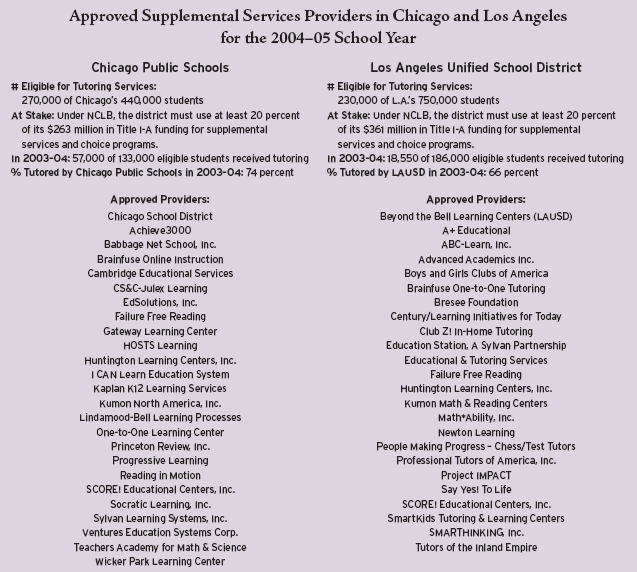
During the summer of 2002, Martha Fritchley was leafing through the Yellow Pages in search of tutoring firms. As an assistant superintendent of the Hall County school system in Georgia, Fritchley needed to enlist firms to tutor children in four underperforming schools in order to comply with the federal No Child Left Behind Act. She was particularly interested in home-based tutoring, and she happened on the local franchise of a company called Club Z.
Fritchley called the franchise’s owner, Scott Morchower. While Morchower was unaware of the new federal law’s tutoring provision, he was of course receptive to the idea. He offered his services to several more districts as well, becoming the sole provider in the 2002-03 academic year of tutoring services for Forsyth County’s 75 struggling students. Some of those students jumped as many as three grade levels.
“The results we came out with were awesome,” says Morchower. So awesome, in fact, that he worked himself out of a contract: all the schools in Forsyth County left the failing schools list, meaning that their students were no longer eligible for tutoring services. During the 2002-03 school year, students in the supplemental services program made up 20 percent of his business; Morchower figured they would account for 40 percent in 2003-04. Instead, they again made up 20 percent. With such an unpredictable flow of clients, how should Morchower factor children from the federal program into his business plan? “I wish I knew,” he says. “That’s the $10 million question.”
By some estimates it’s actually the $2 billion question. That’s how much additional revenue some tutoring providers say could be up for grabs in this new federally funded marketplace. But so far, less than 10 percent of eligible students are electing to participate, according to providers’ estimates. Morchower said one of his toughest challenges is convincing parents that the service is free to them. Parents will often hang up on him because they think he’s a telemarketer, he says. And sometimes parents simply don’t want to acknowledge that their child needs help. “Even when I come out to the house, they ask, -What’s wrong with my kid?’” Morchower says.
These tutoring services, known in the law as “supplemental services,” arguably represent the federal government’s largest free-market experiment in education. In the rush to capture market share, more than 1,000 tutoring providers have signed up for the program. But market uncertainty, combined with differences in how school districts are administering the law, has produced some extremely rocky terrain for these firms. While most providers maintain an optimistic if-you-build-it-they-will-come mindset, the unevenness of parental participation and program implementation is causing significant anxiety.

The New Marketplace
Under the No Child Left Behind Act of 2001, supplemental educational services are funded by school districts with a portion of their allocation from the U.S. Department of Education. Georgia was early to implement its program; most states were just getting on board during the 2003-04 academic year.
States first approve a group of tutoring providers. Then districts draw up their own contract with a subset of those providers; districts themselves can also serve as providers. Once the districts notify parents of their options, parents can enroll with a provider of their choosing.
Within this new marketplace, school districts hold enormous power as a result of their dual role-as both program administrator and potential provider. Districts also have little incentive to inform parents of the money available to them for tutoring, since districts get to keep any unused funds. Some providers allege that districts are not actually setting aside the money as required by law. “We’ve seen districts where the federal per-pupil allocation says it’s $1,800 and the district will say it’s $1,100,” said one provider. “What happens to that other $700?”
The district’s dual role also gives rise to a conflict of interest. The concern is that districts enjoy an unfair advantage over other providers because of their direct access to parents. Jeffrey Cohen, president of Catapult Learning (the tutoring firm formerly known as Sylvan Education Solutions), says that he has seen letters sent out by the district that automatically sign children up for the district’s program unless the parent affirmatively decides to go with a different provider. “There’s not a level playing field,” he says.
To overcome these obstacles, most large providers are going around the districts by beefing up their own marketing efforts. Some providers, like Catapult Learning, are running ads and touting their programs with leaflets or promoters who go door-to-door, to shopping malls, and, when allowed, to the school.
Before No Child Left Behind, about $2 billion was spent each year in the retail tutoring market, according to Educate Inc., a national tutoring company formerly known as Sylvan Learning Systems and Catapult Learning’s parent company. Half of the tutoring providers were small local companies and individuals, while the other half were regional or national firms. In addition to the retail tutoring market, a few companies, such as Catapult Learning, made an effort to promote public-private partnerships in tutoring, but the marketplace was not well defined.
It has been difficult to get a handle on the scope of the market for publicly funded tutoring created by the No Child Left Behind Act because the program is new and has so many moving parts. According to the U.S. Department of Education, private firms represented 72 percent of providers as of spring 2004. Of all providers, 6 percent were faith-based institutions and 10 percent were online tutoring firms. About a quarter of the providers were part of the public school system. Within a given state, public schools represent anywhere from zero to 80 percent of the providers. Likewise, among the states, online providers compose anywhere from zero to 47 percent of the available options.
This nascent marketplace has all the components of a high-school melodrama; there is the popular crowd, the bullies, the overachievers, the earnest do-gooders, and the geeks. (The leading roles are played, in order, by large corporate tutoring providers; school districts; smaller national providers; local, largely nonprofit organizations; and online tutors.) At present, large corporate providers and school districts seem to be ruling the marketplace. And their shares are likely to increase as the program matures because of their ability to meet market demands. But without a chaperone in this new free-market niche in public education, it’s been a schoolyard free-for-all.

SOURCES: Chicago Public Schools; Illinois State Board of Education; Los Angeles Unified School District; Chicago Sun-Times; Chicago Tribune
The Popular Crowd
Jeffrey Cohen was following the supplemental services program long before it became law. As president of Catapult Learning, Cohen saw enormous potential for expansion under a federally funded tutoring program because it mirrored what he had already been doing for 15 years-partnering with low-income schools to bolster their academic programs.
With their glossy brochures and brand recognition, large corporate providers are the popular kids. While there are 60 corporate tutoring providers that can be considered national firms, only a handful of them are real players. This small, elite group has the potential to garner a large market share because many of its members are approved in 20 to 30 states. They have also been tutoring K-12 clients for many years. So these companies are well positioned to scale up their business without enormous start-up costs, enabling them to take advantage of a growing, if unpredictable, market.
Catapult Learning’s business model in this new marketplace is largely the same as before, with one exception: while Cohen deals solely with schools in his regular business, under supplemental services, he must get approved by the state, contract with a district, and then sell his product directly to parents.
Cohen says the supplemental services program offers him two opportunities: 1) to reach many more children, whose schools would not otherwise pay for Catapult’s services; and 2) to build relationships with school districts, which could lead to further business outside the federal program.
At the beginning of the 2003-04 school year, Catapult Learning was approved in 31 states. During the year, the firm served 25,000 students through the supplemental services program, up from 6,000 students the previous year. Catapult charges anywhere between $40 and $80 an hour. In the coming years, Cohen says his supplemental services enrollment will be in the “tens of thousands”; down the line, it could double his pre-supplemental services enrollment of 70,000 students. So far, though, Catapult remains in investment mode. “The first year, the program certainly wasn’t profitable,” Cohen says. His strategy is to ensure that Catapult is operating in as many locations as possible so that it is poised to take advantage of new business as parental demand picks up.
In contrast to Catapult’s efforts to market directly to parents, Princeton Review, which is now approved in 27 states, has taken a school-based tack, negotiating with districts in the hopes of becoming a district’s or a school’s sole provider. The goal is to avoid the headaches of working with school districts that are dragging their feet in implementing their programs. “I don’t look at this as a retail business, like putting up billboards on the highways,” says Rob Cohen, executive vice president of the company’s K-12 division. “I’m looking for districts to call us up.”
During the 2003-04 school year, Princeton Review served 6,000 supplemental services students. Within the next few years, Cohen says his company could be serving as many as 10,000. “I believe we’re running supplemental services, on a marginal basis, profitably today,” he says.
A third strategy among big tutoring companies-a strategy popular among retail tutoring companies that operate from a storefront, like Huntington Learning Centers-is to continue just as they have been doing. These companies get state approval, contract with districts, and then open their doors. Transportation to these tutoring centers, which are often located in suburban strip malls, is up to the parents. For companies like Huntington, says Russ Miller, vice president for new business development, this presents the biggest challenge: getting students to come. Huntington is evaluating two new options for reaching supplemental services students. One is to establish centers in urban areas. The other is to partner with schools-in a strategy similar to Princeton Review’s-to make the school a kind of learning center.
Competitors expected one player in this category, Edison Schools, to jump into the market immediately. Instead, Edison did not begin marketing itself as a tutoring provider until the late spring of 2003, after a year long research effort. So far, the national school-management firm has gotten approved in only 15 states. Nonetheless, largely due to the contract Edison signed with the New York City school system, its enrollment has grown quickly: the firm served 12,500 students in the 2003-04 school year, said Joel Rose, who heads up Edison’s supplemental services division, known as Newton Learning. Edison is among the companies with the most to gain from a successful supplemental services program because its core business depends on building relationships with school districts.

The Bullies
John Liechty knows a market when he sees one. At the beginning of the 2003-04 school year, 186,000 of the nearly 750,000 students in the Los Angeles Unified School District were eligible for supplemental services (see Table 1). As the associate superintendent for extended-day programs, Liechty wanted to keep the tutoring money in the district. He also saw the program as a chance to tap new ideas from private companies. So he applied to the state to be a supplemental services provider and then designed a Saturday school program that would contract out the curriculum and teaching to private providers.
While each district’s reach is limited in scope, school districts, with their ability to be a provider and to control the districtwide funding, have an enormous amount of control over the tutoring options available. That level of control offers up the opportunity for districts to bully other providers, and they are wielding that power in both obvious and subtle ways. Some districts, like Los Angeles, use their status to contract with private providers. Others, like Toledo Public Schools, have opted to develop their own programs.
In Los Angeles, about two-thirds of the 18,550 students who signed up for tutoring in the 2003-04 school year joined the district’s “Beyond the Bell” program (the other third signed up directly with the provider of their choice). Liechty is responsible for running the district’s tutoring program and for administering the supplemental services program, which includes 24 different providers who have signed contracts with the district.
Each of the district’s six tutoring centers is run by a different company, like Kaplan or CompassLearning. “Each one of those centers becomes almost a lab,” Liechty says. “I’m looking for everybody and anybody to partner with.” Liechty says the benefit of this arrangement is that the district can exercise more quality control and can bargain down the price. Liechty hopes to increase enrollment in the next several years to between 20,000 and 25,000 students. He also needs to figure out how to meet the children’s needs without dipping into general district funds. So far, he is operating at a deficit, which he estimated at somewhere between $40,000 and $400,000.
Liechty says that while he tries to run the district’s program fairly, he acknowledges that the district has an inside track with parents. “We don’t hide that,” he says. “There’s no question the district is going to have an advantage.” In addition, the money going to private providers comes out of a pot of federal money that districts have historically counted as their own, and they are understandably reluctant to lose those funds.
The Overachievers
Mark Lucas was skeptical about the opportunities presented by the new federal tutoring program. As the CEO and founder of Club Z’s national operation, he wasn’t sure the federal money would ever reach the pockets of for-profit providers. But when some Club Z franchises were awarded contracts, Lucas’s royalties increased tenfold. That got his attention.
Meet the overachievers. Club Z is one of a number of smaller, national corporate players that have an opportunity to tap into an important niche: parents who want the reliability of a national company but the feel of a local tutor.
Launched in 1995, Club Z’s claim to fame is that it offers in-home tutoring. Across the country, Club Z’s regular program serves 50,000 students a year. After Lucas saw the surge in royalty checks, he decided the whole company should get into supplemental services, and he applied for state approval. In the 2003-04 school year, Club Z was approved in 25 states and served 7,000 children through the supplemental services program. That’s more than competitive with his more-established counterparts. Lucas anticipates that within two years, he’ll be serving around 10,000 students through supplemental services.
“One of the reasons we’re so popular is we go to the home,” Lucas says. How can he do it? Club Z trains a bevy of local tutors and then calls on them as needed and pays them only for the hours they work. Overhead costs are minimal, and Lucas says that Club Z is able to attract better tutors because it pays them half of the $35 hourly rate. He says that compares favorably with his larger competitors, which pay their tutors around $9 an hour. And Club Z isn’t much more expensive than, say, Princeton Review, which charges around $25 an hour. So Club Z offers parents fewer hours of tutoring, but one-on-one and at home.
The Earnest Do-Gooders
The federal tutoring program has been a boon for Pastor Darius Pridgen at True Bethel Baptist Church in Buffalo, New York. A former school board member, Pridgen started a math tutoring program at his church four years ago to help students pass New York’s graduation requirement. But with a $4,000 budget and an all-volunteer tutoring force, the program was “mediocre,” Pridgen says. But after a state assemblyman suggested he take advantage of the federal tutoring money, Pridgen says, “the picture has changed dramatically.” After it joined forces with the housing project next door-home to many children who attend a failing school nearby-True Bethel’s program doubled in size from 50 to 100 children.
A number of community-based groups, including YMCAs, Boys and Girls Clubs, and churches, have added or expanded tutoring operations because of the federal tutoring money. Similarly, a number of 21st Century Community Learning Centers, established by the federal government in the 1990s to provide after-school care, are entering the supplemental services market.
Nonprofits such as these may represent the largest proportion of providers nationwide because they’re the clean-up crew. When the national companies decide a given area isn’t going to boost their bottom line, local organizations are the only option parents have outside the public schools.
At True Bethel, Pridgen has switched from volunteer to hired tutors, and a certified teacher is on-site during the after-school program-all enabled by the new $100,000 budget, $80,000 of which comes from supplemental services. A member of the congregation, a math teacher, offered to work with a few colleagues to write the curriculum. While the program was previously available only to members of the congregation, this one is open to everyone, and the church provides limited transportation with its own bus.
The Geeks
In the spring of 2002, Massachusetts’s state department of education called Burck Smith. His start-up company, SMARTHINKING, offered live, online, one-on-one tutoring 24 hours a day to college students. Department officials asked if SMARTHINKING would be able to offer a similar service for struggling 10th graders who needed to pass the state test. Smith, who had founded SMARTHINKING in 1999, thought he’d give it a shot. “We’d always thought we’d move into high-school tutoring,” he said. “The overlap between high school and college tutoring is really dramatic.”
The geeks are doggedly trying to make virtual tutoring as good as the real thing. Representing perhaps less than 1 percent of the more than 1,000 unique providers nationally and 10 percent of the 1,718 approved providers in each state, online tutoring firms are still an unknown quantity. But they could fill an important niche in serving students who don’t want to or can’t get to a site-based provider. Other major providers, such as Catapult Learning, are exploring ways to establish online tutoring services.
SMARTHINKING is now approved in 15 states, and it served 200 children during the 2003-04 academic year, though Smith had hoped to reach 800. He attributes the low turnout to increased competition from other providers in the program’s second year. Smith is facing the same low-participation problems as his competitors, but he has a unique problem with attendance. Smith learned from his program in Massachusetts that students are more likely to attend when they have to show up at a supervised center to log in. So he’s pursuing that option where possible.
Nevertheless, Smith believes that his online business model is perfect for the supplemental services program. While other companies need a critical mass of students to ensure profitability, Smith doesn’t. Furthermore, he has no fixed costs associated with delivering his program-beyond what he has already spent to develop the software. SMARTHINKING has quality advantages, too, says Smith. With a decentralized business model, he can get higher-quality employees; more than 80 percent of his tutors have master’s or doctoral degrees. He also provides Spanish-speaking tutors when necessary. And it’s no trouble to bring his services to scale if there’s a surge in interest. In a few years, Smith hopes to be serving 10,000 supplemental services students.
Survival of the Largest
As this marketplace matures, both experts and a number of providers say two big winners will emerge: corporate providers and school districts. Those organizations possess the greatest resources, the greatest capacity to reach parents and children, and the scale to absorb the unpredictability inherent in this marketplace.
Ultimately, those two groups may join forces. A number of large corporate providers said that the supplemental services program may end up looking a lot like the one in Los Angeles, in which the district contracts with a few big companies to deliver the tutoring. “I think the largest provider nationwide will be schools,” says Rob Cohen of Princeton Review. “They have all the teachers. They have all the buildings.” And they have the greatest ability to deliver the children.
Cohen thinks this is a good thing. While he acknowledges that providing the services directly to children is more profitable, he may be able to get a greater share of a new market that sells materials to public schools than he can in the current marketplace. “Providing services to the No. 1 provider [districts] is going to be a fine place to be in the market,” he says. And it may well be the best way to ensure that the districts have incentives both to participate and to monitor private providers.
In this Darwin-meets-public-education school reform, performance will (hopefully) matter a lot, too. That detail is not lost on most large providers. “The playing field has grown tremendously. Those who will rise to the top will be those who are getting results,” said Huntington’s Miller. “They’re going to gauge the results by their test scores’ going up. That’s going to be the bottom line: Did the scores improve, and if they did, which provider did the student work with?”
That’s the ideal, anyway.
-Siobhan Gorman is a staff correspondent with National Journal.


